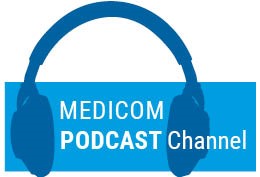https://doi.org/10.55788/951fa9e7
“Advances in treating MS over the past 40 years have been substantial,” stated Prof. Hauser. In his lecture, he identified 3 topics to discuss to advance towards the ultimate goal of curing MS [1].
Treating early
Since disability is usually irreversible, early intervention is needed to maximise response. Prof. Hauser commented: “In the early stages of MS, the autoimmune response is more focused, but we have made little progress thus far in identifying the earliest specific MS triggers. The earlier we can intervene, the greater the likelihood of achieving maximum – and possibly complete – control.”
Prof. Hauser observed that genetics may contribute incrementally to identifying early MS, but a specific MS signature has been lacking. Over 230 loci associated with MS susceptibility have been identified, but these exert a negligible effect on disease severity. He added that recently a new variant associated with MS severity was identified, rs10191329 in the DYSF–ZNF638 locus [2]. “Genetics play an incremental role, but cannot really distinguish who is at risk,” said Prof. Hauser.
“In other auto-immune diseases, serological auto-antibodies have been by far the most effective biomarkers to define the presymptomatic phase,” Prof. Hauser stressed. Examples include lupus, diabetes, and rheumatoid arthritis. Insights into their phase of ‘benign autoimmunity’ has helped designing trials of treatments that interrupt auto-immunity at the earliest possible stage. “We are moving closer to being able to do the same in MS,” Prof. Hauser noted. For example, a recent study identified an immunogenic cluster that was exclusively present in MS patients, both before and after diagnosis [3]. Prof. Hauser reported that “this cluster is commonly expressed in a number of pathogens, with the closest homology being the early lytic antigen of the Epstein-Barr virus, BRRF2,” and added that even in the pre-symptomatic stage, the signal was associated with increased serum neurofilament light levels.
“We have an immense opportunity to advance from partial to complete suppression, to cure,” Prof. Hauser said. Foremost is the importance of having biomarkers: imaging, proteomic/genomic, and immune biomarkers of cell-type specific myelin damage, Prof. Hauser added; in short, a toolbox for ‘silent’ pathologies. These biomarkers need to be scalable and harmonised.
Realising that a cure is realistic
A cure for MS is realistic, but a working definition is needed. For this, a look at the field of oncology may be instructive, according to Prof. Hauser. There, patients with childhood B-cell acute lymphocytic leukaemia who maintain treatment-free complete remission status for 4 years, have a <1% lifetime risk of relapse: they are effectively cured. A complete response equivalent for MS could also be developed. “A cornerstone of this would be normalisation of cerebrospinal fluid,” added Prof. Hauser.
Understanding that the cellular drivers of MS are likely to be heterogeneous
Prof. Hauser noted intriguing and ‘provocative’ findings of recent trials of haematopoietic stem cell transplantation, cladribine, and alemtuzumab, all of which target multiple cells, adding that “next-generation therapeutics will likely need to neutralise multiple cell types, including treatment-resistant B cells, microglia, and CD8-positive T cells.”
In closing, Prof. Hauser identified ‘the big issues’ the field of MS is facing, which will need to be answered in collaboration with patients, funders, insurance, and the pharmaceutical industry:
- induction and maintenance regimens;
- optimal duration of therapy (including when to stop); and
- off-treatment monitoring protocols.
“The past 40 years in the MS field have been amazing,” Prof. Hauser concluded, “But I think the next generation will have an even more exciting time than we have had.”
- Hauser S. Multiple sclerosis – path to a cure. O027, MSMilan 2023, 11–13 October, Milan, Italy.
- Multiple MS Consortium. Nature. 2023;619:323–331.
- Zamecnik CR, et al. medRxiv. 05.01.23288943. DOI: https://doi.org/10.1101/2023.05.01.23288943. (Preprint)
Copyright ©2023 Medicom Medical Publishers
Posted on
Previous Article
« Letter from the Editor Next Article
Fenebrutinib shows rapid reduction of new Gd+ T1 lesions »
« Letter from the Editor Next Article
Fenebrutinib shows rapid reduction of new Gd+ T1 lesions »
Table of Contents: MSMilan 2023
Featured articles
Letter from the Editor
Real-world data supports ocrelizumab prior to conception
Progressive MS
Early initiation of highly active treatment associated with a lower risk of SPMS
Ocrelizumab more effective than interferon/glatiramer acetate in older MS patients
Paediatric MS
Prioritising high efficacy therapies in children with MS
Omega-3 polyunsaturated fatty acids associated with lower risk of MS activity
NMOSD & MOGAD
An update on evolving treatment algorithms for NMOSD and MOGAD
Women’s Health
Rate of grey matter brain atrophy accelerates after menopause
Real-world data supports ocrelizumab prior to conception
Miscellaneous
New insights into the contribution of EBV to MS pathogenesis
COVID-19 infection associated with higher MS relapse rate
Telerehabilitation effective in improving MS symptoms in patients with moderate disability
Curing MS
Understanding what an MS cure means and what it takes
Prodromal MS
Progressive brain tissue loss precedes the onset of clinical MS by years
Sickness absence rate increases years before clinical onset of MS
Treatment Trials and MS Strategies
Early intensive treatment enhances long-term clinical outcomes
Oral glycolipid shows promise in the treatment of MS, especially SPMS
Fenebrutinib shows rapid reduction of new Gd+ T1 lesions
Challenges of de-escalation versus discontinuation of highly effective DMTs in older MS patients
Biomarkers & Imaging
χ-separation can assess the effects of tissue destruction in early MS lesions
High sGFAP levels are associated with disease progression, independent of NfL or relapse activity
Broad rim lesions correlate with a rapidly progressive MS phenotype
Smouldering inflammation detectable even in the earliest stages of MS
Related Articles
November 8, 2019
Challenges in diagnosing and treating progressive MS
December 4, 2023
Fenebrutinib shows rapid reduction of new Gd+ T1 lesions

September 28, 2020
MS Virtual 2020 Highlights Podcast
© 2024 Medicom Medical Publishers. All rights reserved. Terms and Conditions | Privacy Policy

